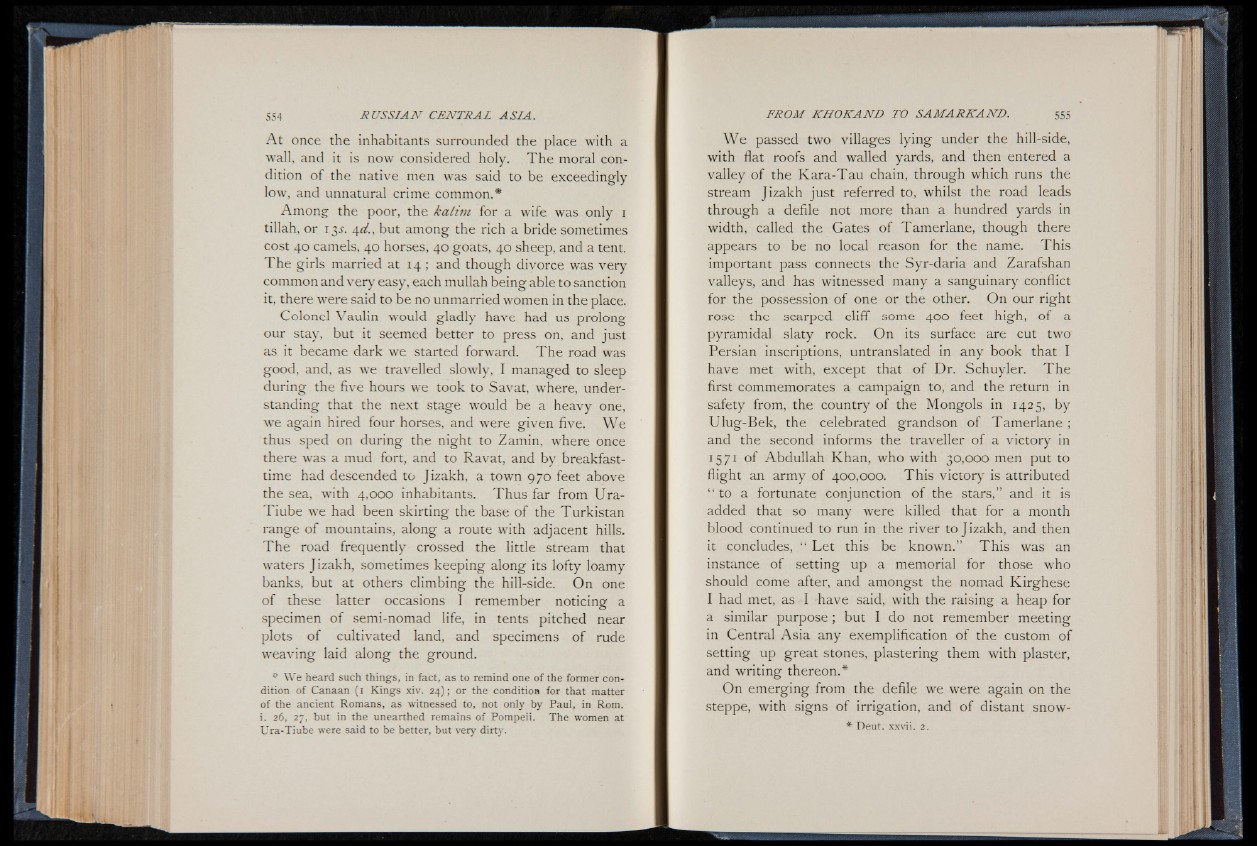
A t once the inhabitants surrounded the place with a
wall, and it is now considered holy. The moral condition
of the native men was said to be exceedingly
low, and unnatural crime common.*
Among the poor, the kalim for a wife was only i
tillah, or 13^. 4d., but among the rich a bride sometimes
cost 40 camels, 40 horses, 40 goats, 40 sheep, and a tent.
The girls married at 14 ; and though divorce was very
common and very easy, each mullah being able to sanction
it, there were said to be no unmarried women in the place.
Colonel Vaulin would gladly have had us prolong
our stay, but it seemed better to press on, and just
as it became dark we started forward. The road was
good, and, as we travelled slowly, I managed to sleep
during the five hours we took to Savat, where, understanding
that the next stage would be a heavy one,
we again hired four horses, and were given five. We
thus sped on during the night to Zamin, where once
there was a mud fort, and to Ravat, and by breakfasttime
had descended to Jizakh, a town 970 feet above
the sea, with 4,cxx> inhabitants. Thus far from Ura-
Tiube we had been skirting the base of the Turkistan
range of mountains, along a route with adjacent hills.
T he road frequently crossed the little stream that
waters Jizakh, sometimes keeping along its lofty loamy
banks, but at others climbing the hill-side. On one
o f these latter occasions I remember noticing a
specimen o f semi-nomad life, in tents pitched near
plots of cultivated land, and specimens of rude
weaving laid along the ground.
0 W e heard such things, in fact, as to remind one of the former condition
of Canaan ( i Kin gs xiv. 24); or the condition for that matter
of the ancient Romans, as witnessed to, not only by Paul, in Rom.
i. 26, 27, but in the unearthed remains o f Pompeii. The women at
Ura-Tiube were said to be better, but very dirt)'.
We passed two villages lying under the hill-side,
with flat roofs and walled yards, and then entered a
valley of the Kara-Tau chain, through which runs the
stream Jizakh just referred to, whilst the road leads
through a defile not more than a hundred yards in
width, called the Gates of Tamerlane, though there
appears to be no local reason for the name. This
important pass connects the Syr-daria and Zarafshan
valleys, and has witnessed many a sanguinary conflict
for the possession of one or the other. On our right
rose the scarped cliff some 400 feet high, of a
pyramidal slaty rock. On its surface are cut two
Persian inscriptions, untranslated in any book that I
have met with, except that of Dr. Schuyler. The
first commemorates a campaign to, and the return in
safety from, the country of the Mongols in 1425, by
Ulug-Bek, the celebrated grandson of Tamerlane ;
and the second informs the traveller o f a victory in
1571 of Abdullah Khan, who with 30,000 men put to
flight an army of 400,000. This victory is attributed
“ to a fortunate conjunction of the stars,” and it is
added that so many were killed that for a month
blood continued to run in the river to J izakh, and then
it concludes, “ Let this be known.” This was an
instance of setting up a memorial for those who
should come after, and amongst the nomad Kirghese
I had met, as I have said, with the raising a heap for
a similar purpose; but I do not remember meeting
in Central Asia any exemplification of the custom of
setting up great stones, plastering them with plaster,
and writing thereon.*
On emerging from the defile we were again on the
steppe, with signs of irrigation, and of distant snow-
* Deut. xxvii. 2.